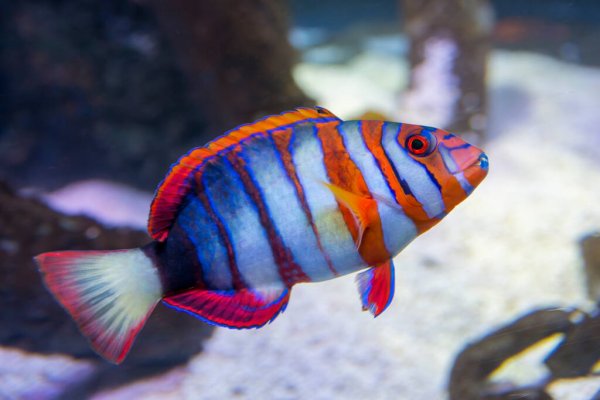ANIMAL: Harlequin Tuskfish Choerodon fasciatus Type of Animal: Wrasse Habitat: Tropical/subtropical waters-reefs, seagrass beds, lagoons on outer reef edges, reef slopes, caves/cave vicinities, reef walls, overhangs on reef slopes, reef-sand interface, coastal areas, open ocean Location(s): Indo-Pacific Appearance: Multi-colored striped pattern, has orangish-red/blue/green colors, darkens w/ age, protruding blue tusk-like teeth Food/Diet: Crustaceans, mollusks, echinoderms, worms, plankton, fish, sea veggies Status in Wild: Stable Conservation: Breeding in aquariums, aquaculture, & zoos. Captive breeding reducing demand for wild-caught fish. Lifestyle: Solitary or small harems of a male w/ 2-3 females. These fish all born female w/ largest/most dominant female becoming male. If male dies, next most dominant female changes sex. Additional Info: Called: Male Female Young: Fry Group: School Weight: Male: 1-1.5 lbs Female: 0.5-1 lb Gestation: 1 day Life Span: 10 years Body Length: Male: 7-12 in Female: 5-8 in Young: 2 in Tail Length: 1.8-2 in, same for both sexes Main predators are larger fish, moray eels, & sharks. Spawn in open water, producing large number of planktonic pelagic eggs. These fish are very difficult to breed in captivity. They’re a very mild-mannered fish. They’re rather shy in the wild. Eyes move independently of each other & aid in surveying for both predators/prey. Black eyespots on fins serve to draw predator’s attention to less vulnerable body parts. Rely on eyesight to find food. Use tusk-like teeth to open harder-shelled prey. Active during the day (diurnal). To expose any prey buried in sand, they’ll turn away, snapping gill covers shut blasting water creating waft of air. Get tuskfish name due to tusk-like teeth. Males guard territories fiercely. Fun Fact(s): Unlike many wrasses, they don’t bury themselves in sand at night. Sometimes called Harley Quinn Tuskfish & Harley. Besides their teeth, their bones are also blue. They can change teeth color from blue to pink if threatened. It’s recommended to get Australian-based fish due to more ethical shipping techniques. Bright coloration may be form of mimicry & deter predators due to thinking it’s poisonous. These fish are not poisonous. They’ll carry clams/other hard-shelled prey to home territory where they’ll fling them against hard surfaces allowing prey to be broke open.
